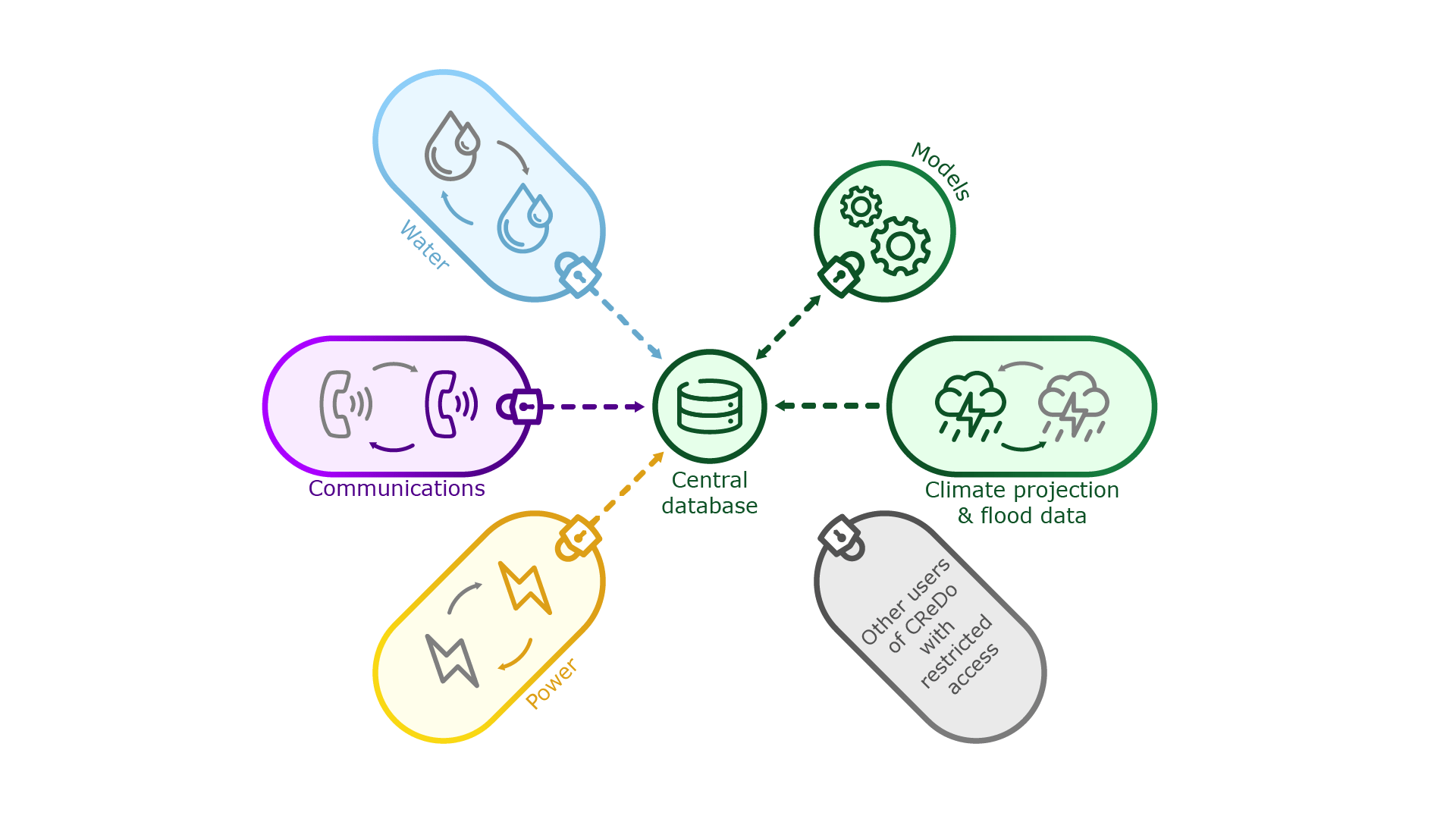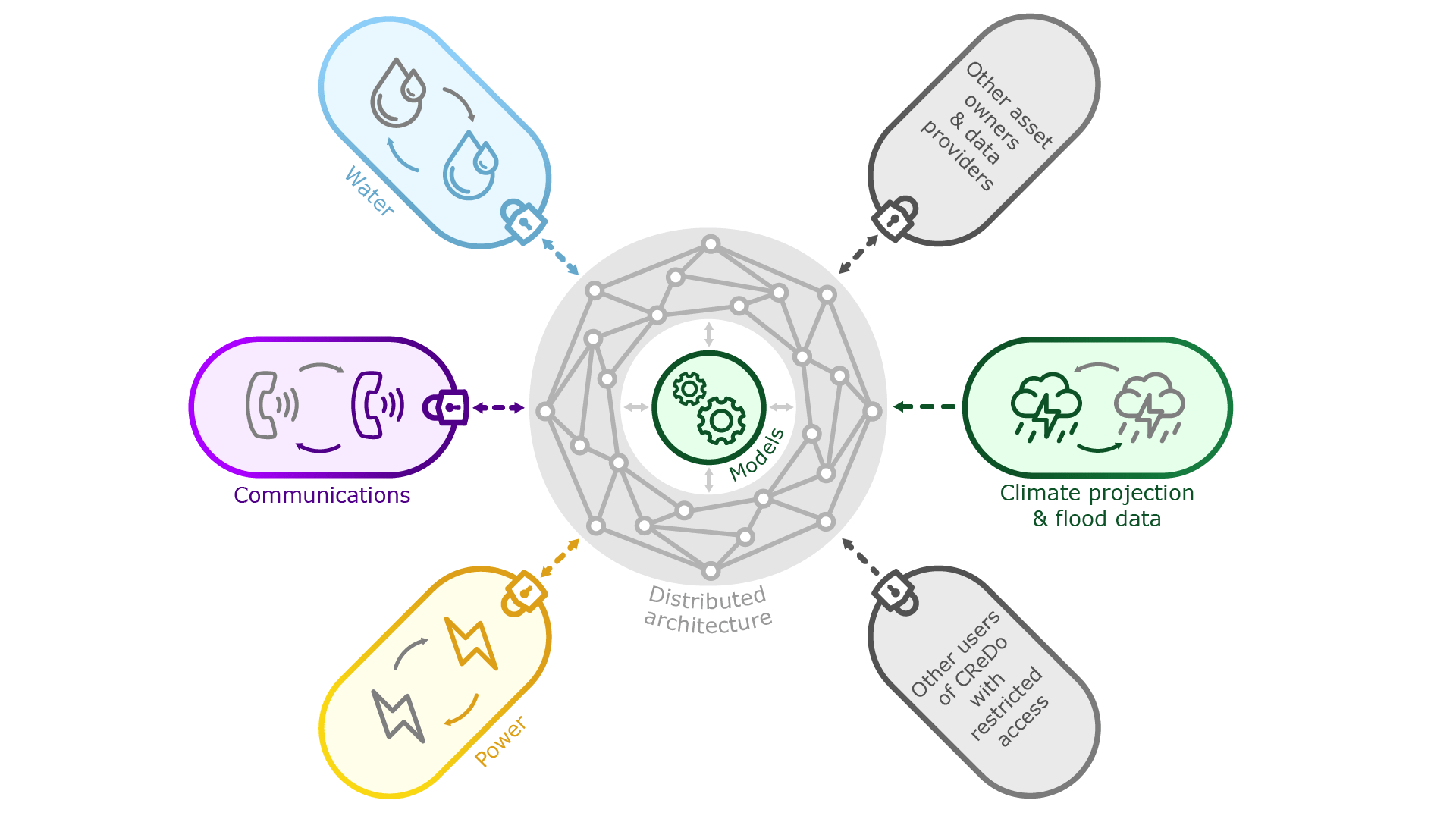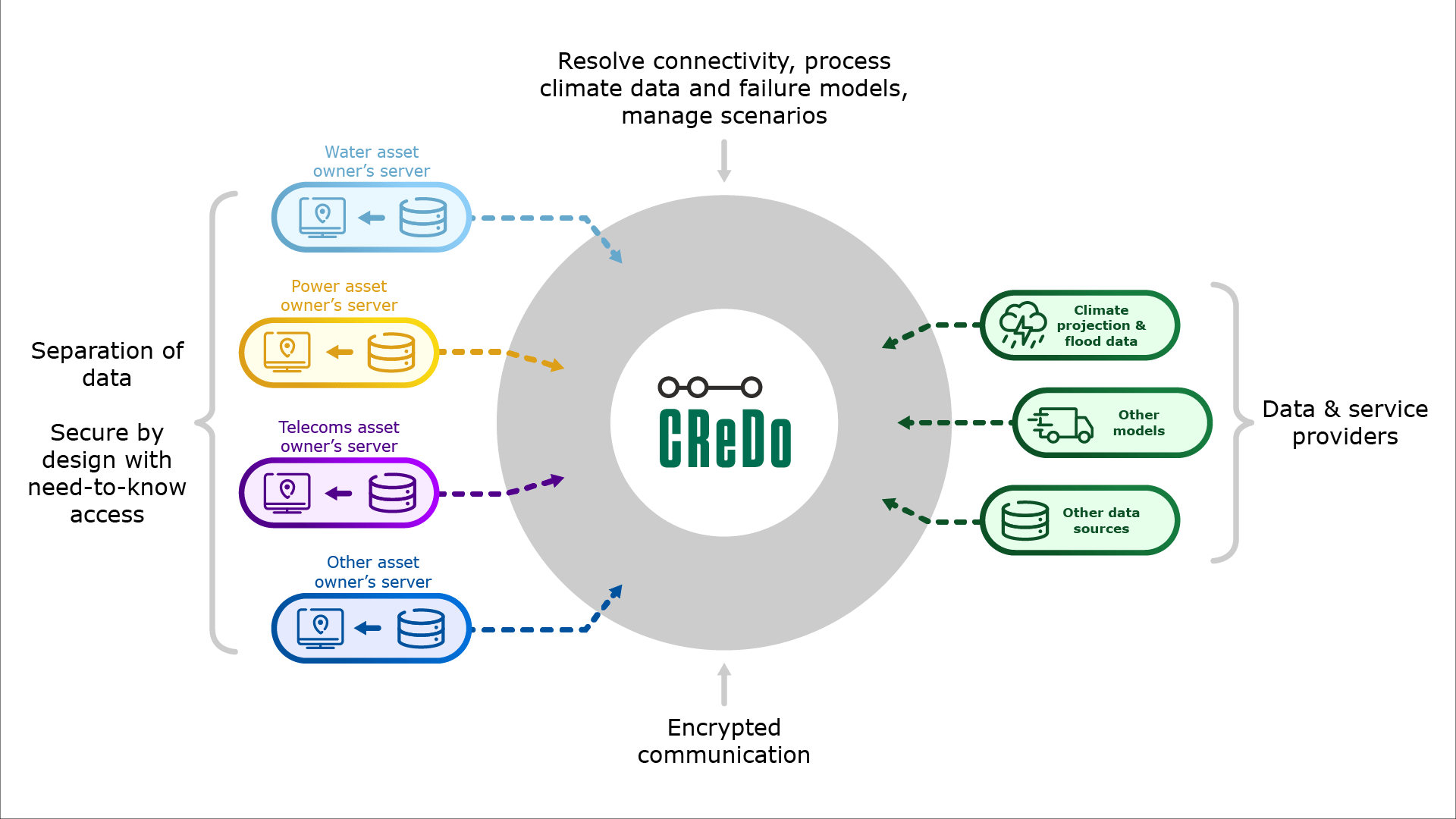Case Study:
CReDo Phase 2
This case study uses content from the reports hosted by The Digital Twin Hub.
Read the full reports here.
Introduction
CReDo is a pioneering project to develop a digital twin across infrastructure networks to provide a practical example of how connected data and greater access to the right information can improve climate adaptation and resilience. CReDo demonstrates how it is possible to connect data across organisations to deliver efficiencies and wider societal benefits.
Enabled by funding from Innovate UK via Connected Places Catapult, CReDo looks specifically at the impact of extreme weather, in particular flooding, on energy, water and telecoms networks. CReDo brings together asset data, flood hazard data and asset failure models to provide insights into infrastructure interdependencies and how they would be impacted under future climate change flooding scenarios. The vision for CReDo is to enable asset owners, regulators and policymakers to collaborate using the CReDo digital twin to make decisions which maximise resilience across the infrastructure system rather than from a single sector point of view.
This second phase of CReDo running from April 2022 to March 2023 has sought to:
- Move existing CReDo functionality to a distributed architecture where asset owners can host their data assets in their own secure environments , and CReDo can access the relevant data and return insights securely.
- Enable asset owners to see insights from the combined infrastructure network and, by signing up to an additional part of the data licence, a system – level view of the network.
- Build in extensibility to accommodate the future addition of new asset owners and data types.
- Continue to explore and develop methods of promoting interoperability.
- Unlock the strategic resilience planning use – case by enabling asset owners to access real data for both their own and interconnected assets via CReDo.
CMCL's Contribution
CMCL were engaged by Connected Places Catapult to develop a distributed architecture for the CReDo digital twin. The internal data structure of CReDo is based on the use of ontologies to represent information as a knowledge graph. The nodes of the knowledge graph represent data as instances of concepts that describe the type, operational state and location of each asset, and the edges of the graph represent relationships between nodes.
The ability to scale and extend CReDo is critical to understanding the interaction between networks and the impact of cascading risk. These questions motivated the development of an extensible distributed architecture in CReDo Phase 2 to enable the possibility of allowing asset owners to share data and benefit from insights based on the combined network, whilst retaining control of their data within their own IT systems.
The figure below illustrates the centralised data sharing architecture used during CReDo Phase 1 and the distributed architecture demonstrated in CReDo Phase 2.
An additional requirement was for the distributed architecture to be able to host scenarios defined by a combination of asset and hazard data. By comparing different scenarios, we can understand the vulnerability of the combined asset network to different climate scenarios and can understand the difference in implications for different time horizons, 2030, 2050, and 2070 for example, and for different hazards, for example coastal, fluvial and pluvial flooding. The differentiation is important because the type of protection required from saltwater flooding may be quite different from that required for protection for freshwater flooding. The ability to host scenarios additionally provides the possibility of hosting data describing alternative asset bases, for example the planned configuration of the water network in 2030. The ability to assess the implications of future plans on the combined asset network is a vital component of strategic resilience planning.
The distributed architecture used in CReDo Phase 2 is shown in the figure below. The asset owner data is hosted on separate servers, which could be hosted by asset owners in their own IT systems. The distributed architecture enables CReDo to connect securely to a copy of the data held on these servers, and could also enable the possibility to connect directly to asset owner data at source. By separating the data, the architecture seeks to avoid the risks associated with hosting all the data in the same place. Each asset owner server also hosts a visualisation, providing a means to facilitate different views of the insights and data. In the current implementation, a central node is responsible for resolving the connectivity between assets, for running the models that simulate asset failures and the impact across the combined asset network, and for managing scenarios. The architecture enables other data and service providers to contribute to CReDo
Findings
CReDo Phase 2 modified the implementation of the knowledge graph to adopt a distributed architecture that integrates remotely hosted data. The distributed architecture enables the possibility of asset owners sharing data about their infrastructure and receiving insights based on the combined infrastructure network, while simultaneously retaining control of their data assets within their own IT systems.
The use of hierarchical ontologies together with the distributed architecture combine to make CReDo scalable and extensible. CReDo can accommodate:
- Additional infrastructure, for example new asset owners and new types of assets, by defining new specialisations of the core ontology and by connecting to a new server hosting the data. This has been demonstrated by the addition of the NHS data in CReDo Phase 2.
- Other climate projection and weather hazard data. This has been demonstrated by the addition of the flood hazard data supplied by Fathom in CReDo Phase 2.
- Multiple views of the infrastructure data. This has been demonstrated by the availability of both system – wide and restricted views of the infrastructure data in CReDo Phase 2. All views report insights based on the combined infrastructure network, while the restricted views do so without revealing confidential data.
The distributed architecture also permits partially restricted views, for example where a subset of asset owners has an agreement that permits data sharing to calculate insights and visibility of the of the underlying infrastructure data. It is anticipated that the system – wide view may be useful, for example to regulators such as Ofgem, Ofwat and Ofcom, while the flexibility of the (partially) restricted view may remove obstacles to the participation of other asset owners to play a role like Anglian Water, BT and Openreach, and UK Power Networks.
The use of ontologies maximizes outward compatibility. It enables the possibility of mapping data from whatever format is used by asset owners into the CReDo data structure. This is important because it enables compatibility with other data models and standards for information exchange. This allows CReDo to accommodate different asset owners having different data formats. This is critical because digitalisation is journey, and different parties may be in different places on that journey.
The CReDo digital twin has been deployed at STFC in a secure environment within DAFNI. The distributed architecture makes provision for security, access and quality protocols. This has been demonstrated by the development and deployment of a multifactor authentication solution to provide assets owners with secure access to the CReDo on DAFNI.


